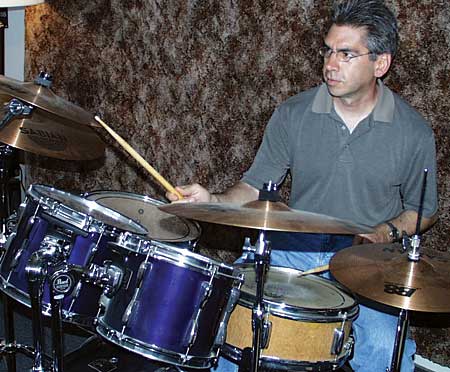| Columns Retired Columns & Blogs |
Allen Perkins: From Bicycles to Belt Drives Page 4
The more expensive SG1 has a bayonet armboard that lets the user change out tonearms in about 10 seconds, as quickly as changing a camera lens. This easily enables the use of different arms with different cartridges. The SG2 has the same armboard without the bayonet mount, and requires 10 minutes to swap arms. Each table has a 14"-diameter ring around the bottom of the 12"-diameter platter to accommodate the drive belt.
"The extra diameter increases the inertia on the platter eight times over what a standard 12" diameter gives," he claimed. "In my opinion, that's much better than adding eight times the weight to the same size platter. There's a limit to what mass is good for."

Perkins's platter, which he began to develop while still at SOTA, comprises layers of different materials, with the bottom layer stainless steel (SG1) or aluminum (SG2). The next layer is a porous material, such as cloth or paper, impregnated with phenolic glue. Perkins finds this material extremely dead and inert, and easy to accurately machine. Then comes ¼" of vinyl. The platter's top layer is a ¼" thickness of graphite, whose lossy composition dissipates reflected vibrations.
Much of the platter's sound quality derives from the proportions of these different layers. "Any single material has a resonance of some sort," Perkins said. "Putting different materials together cancels the resonances out. I've layered materials that tune well together and produce better sound. You see acrylic turntables all over the place because they're easy to manufacture. Acrylic does a pretty good job, but for me, it's not the final answer for good sound."
In addition to its drive ring, many of the SG1's smaller parts are also of stainless steel: the clamp, pulley, feet, etc. In the SG2, these parts and the drive ring are aluminum, which is lighter, less expensive, and easier to machine. The SG1's base has four layers of aluminum that form a two-piece body; in the SG2, three layers of aluminum form a single block.
"People buy my products for different reasons," Perkins said. "Many come to them after they've experienced several other products with a lot of marketing push behind them. They put them side by side and say, 'Wow. This performs.'"
Spiral Groove DP1 Preamplifier
The forthcoming DP1 boasts a built-in DAC so it can handle both analog and digital input signals, and special outputs designed to accommodate custom-made crossovers that can run multi-amplifier systems.
"It has three outputs," Perkins explained. "You can put a little circuit board with an active crossover in the internal slots. If you design an external crossover to work at that low voltage, you don't risk the problem of losing efficiency by placing huge [capacitors] and resistors in a speaker box, where the power is high. The external crossover gives you much more control, much less distortion, and presents a far less challenging and complex load for an amp. You do have to multi-amp, but the technical advantages and increased efficiency are tremendous. Every time I've ever heard a multi-amp system, my mouth drops open because it's so controlled, so low in distortion, and so effortless.
"Theoretically, we can build a crossover to any speaker designer's spec. We can also give them the specs for the slot, and they can build their crossover and encase it in epoxy. We will also eventually offer it as a feature for a few Sonics [by Joachim Gerhard] speakers. I think it will be very ear-opening for many audiophiles."
The Best of Times
How does Allen Perkins feel about initiating new ventures just as, economically and culturally, so much is shutting down?
"Everybody's got a plan," he told me, "and this is mine. If I could play drums all day and be paid the same, I would do that. But that won't happen. There's nothing else I can think of that I want to do. And it's ideal for my 11- and 15-year-old sons to see me doing something active and pushing forward in my fifties.
"People buy audiophile equipment because they're into listening to music at a very high level. The niche we're in is a pretty resilient one. It's survived all the other depressions and downswings. Many manufacturers will not be able to afford the R&D during these questionable financial times, and you may see far fewer interesting new products to review and listen to than in past years. Now is the perfect time for us to develop and introduce new products. I believe that if I make products that are really high-quality, with high fit and finish, and we back them up well, there will always be a market."
- Log in or register to post comments




































